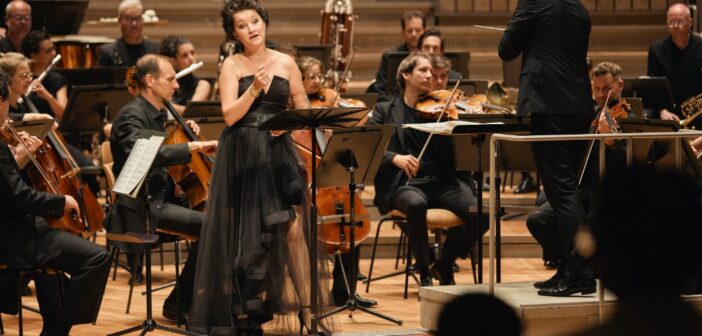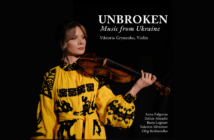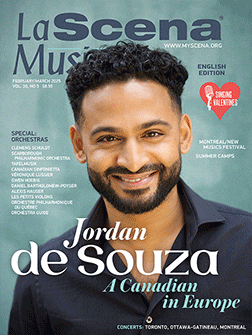Musikfest Berlin is an ambitious annual festival that hosts the world’s top orchestras, instrumental and vocal ensembles, together with the major symphony orchestras of the city of Berlin. Its 20th-anniversary season focuses on the double continent of America and borrows its title, “Amériques”, from France-to-US transplant, Edgard Varèse’s 1921 work that raised the roof at the São Paulo Symphony Orchestra’s festival-opening concert on Aug. 24th.
Acknowledging the ‘American’ theme during his opening remarks, artistic director Winrich Hopp made reference to recent and upcoming European and North and South American elections which have seen far right parties gain more ground than at any other time in recent history. So much of the repertoire at Musikfest Berlin was produced by the most revolutionary composers of their time; artists who faced suppression and displacement by extremist regimes. The current political climate seems to be setting off alarm bells given the hard-won process of revival endured by many of these works, and what stands to be lost in the future.

Philharmonie Berlin. Photo: Fabian Shellhorn
Musikfest Berlin delivers the 20th century
As I discovered last year, Musikfest Berlin holds a unique place on the international festival circuit, especially in the realm of new, or at least, newer music. It is here that you will encounter concertos and large symphonic works by the most important composers of the last 100 years. In the first week alone I heard challenging, large scale works by Alberto Ginastera (his 1963 Violin Concerto), Heitor Villa-Lobos (a 1934 tone poem), John Adams (2001’s Guide to Strange Places), Charles Ives (two early 20th-century fanfares), Luciano Berio (Quatre dédicaces from the 1980s) and Wolfgang Rihm (1974’s Dis-Kontur).
So often, in the Toronto music scene at least, we experience newer music on a small scale. Musikfest Berlin offers an opportunity to encounter 20th and 21st-century compositions played by full-sized symphony orchestras, often alongside more canonical works which were in fact revolutionary in their own time.
This juxtaposition was made most clear in the Gustav Mahler Jugendorchester’s Aug. 30th concert. Under German conductor Ingo Metzmacher, the program opened with Wagner’s Vorspiel (Introduction) to Act 1 of his opera Parsifal. The young musicians captured its suspended transcendence beautifully before segueing unexpectedly into Italian composer Luigi Nono’s 1984 piece dedicated to the great architect, Carlo Scarpa. The latter’s simple, three-dimensional geometric forms found an aural counterpart in Nono’s reliance on the decaying tones of chimes and triangle which then morphed back into Parsifal’s lushly emotional Good Friday Music. This imaginative mash-up prompted reflection about how the mantle of revolutionary music-making has been carried forward, despite the starkly contrasting styles.

Roman Simović & the São Paulo Symphony Orchestra at Musikfest Berlin. Photo: Fabian Shellhorn
By inviting the São Paulo Symphony Orchestra to open the Festival on Aug. 24th, the door was flung open to include all the Americas contained within the festival’s theme. Roman Simović, concertmaster of the London Symphony Orchestra since 2010, gave a virtuosic account of Argentine composer Alberto Ginastera’s 1963 Violin Concerto. Its first “Cadenza e Studi” movement begins with some bracingly rhythmic, unaccompanied work that develops into vibratoless scratching, contrasted with prominent harp and chimes. Both soloist and the orchestra under their music director, Thierry Fischer, laid down the gauntlet as to the uncompromising direction Musikfest Berlin was about to take.
Next, the São Paulo forces offered Brazilian composer Heitor Villa-Lobos’s ballet score/tone poem Uirapurú (1917/1934), named after a South American bird. It’s a lush piece that evokes forest sounds, bird song (a Debussyan flute solo) and gives off an overall ‘primitive’ energy. Amériques (1918-22, rev. 1927) was the first work French composer Edgar Varèse wrote after moving to the United States in 1915. This mammoth creation captures the cacophony of New York City with its siren motif and loudly clapping wood slapsticks.

Composer Allison Loggins-Hull with Franz Welser-Mӧst & the Cleveland Orchestra. Photo: Fabian Shellhorn
The Cleveland Orchestra led by Franz Welser-Mӧst (Aug. 26th) brought the sole ‘new’ work to the first week of the festival, American composer Allison Loggins-Hull’s Can You See? (2023). Opening quietly with a slow ostinato in the strings punctuated by a steady drumbeat, it also contains spooky sci-fi effects from the woodwinds. The composer, who was present, received a warm, extended ovation.
Next, Cleveland offered John Adams’s Guide to Strange Places (2001) based on an old guide book to the “mysterious places of Provence” the American composer found while travelling there with his family. Therefore understandably episodic, it jumps from an agitated string opening at cross rhythms with the xylophone, makes stops for busy percussion paired with long, sustained string glissandi and adds on menacing violin/viola passages against insistent chimes. Its overall effect lacked cohesion, however, with nary a moment for repose nor much that wasn’t fortissimo, making it difficult to tell just where this journey was headed.
The concert closed with Sergei Prokofiev’s Symphony #2 in D minor (1924-25). One of the Russian composer’s least performed works, the harsh dissonance of its opening movement and seamless repose of Frank Rosenwein’s oboe solo in the subsequent “themes and variations” all sounded as revolutionary as they must have done at its 1925 Paris premiere. Despite pushing tonality to its limits, Prokofiev provides an underlying structure and sense of purpose that were only more prominent in comparison to Adams’s rather directionless piece.
Musikfest Berlin honours Ives & Schönberg
Musikfest Berlin doesn’t get too bogged down connecting everything to its main annual theme. So, in addition to the Americas focus, we were treated to several works by Charles Ives (1874-1954) and Arnold Schönberg (1874-1951), both celebrating 150th anniversaries. It was a rare opportunity to compare the radical experiments of these two iconoclasts across several concerts ranging from intimate piano pieces through large scale orchestral works.
On Aug. 28th, the Kansas City Symphony under its newly appointed music director Matthias Pintscher, opened with Ives’s Decoration Day (1912/1931) and The Fourth of July (1911-13) from A Symphony: New England Holidays. The spiky tonalism of the former included offstage trumpet fanfares and the sudden eruption of a marching band contrasted with hushed, sustained passages that caused minor tuning challenges near the start. The national holiday piece offered snippets of popular American tunes submerged within a cacophony of dissonance.

Conrad Tao & the Kansas City Symphony. Photo: Fabian Schellhorn
Kansas offered what was probably the most quintessentially ‘American’ program of the festival that included an entertaining, if entirely self-regarding, outing of George Gershwin’s Rhapsody in Blue (1924) with pianist Conrad Tao improvising and riffing at will. The finale of Aaron Copland’s Symphony No. 3 (1946) opens with his most famous tune, the Fanfare for the Common Man for brass and drums, representing a certain type of American ‘can-do’ optimism. In the overall context of the symphony however, this snippet sounds incongruous in the midst of a more general progressivism.
Pierre-Laurent Aimard plays Ives & Schönberg
Ives returned in pianist Pierre-Laurent Aimard’s extraordinary recital on Sept. 2nd with his piano sonata, Concord, Mass., 1840-1860 (1947). It pays tribute to 19th-century American Transcendentalist writers Ralph Waldo Emerson, Nathaniel Hawthorne, The Alcotts and Henry Thoreau. They rejected formal religion and rationalism, emphasising instead “the individual, the subjective, the imaginative, the personal, the emotional, and the visionary” in their quest for meaning. Ives’s sonata contains jazz, blues, Protestant hymn tunes and organ chorale themes, albeit fragmented within the sonata’s experimental framework.
In the first half of his recital, Aimard focused on Schönberg, the Festival’s other anniversary celebrant. It is rare to hear his solo piano works in any context, let alone played complete as they were here. The early Drei Klavierstücke op. 11 (1909/10) are still somewhat rooted in tonality but even by 1929’s Klavierstücke op. 33a, one can still sense Schönberg’s attachment to the Viennese waltz. The Suite für Kavalier op. 25 (1921-23) plays with French Baroque dance forms including big fanfares in the prelude and virtuoso broken chords bouncing all over the keyboard in the Menuett/Trio. Aimard astonished throughout with technical flourishes tossed off with utter emotional conviction.

Isabelle Faust & Friends at Philharmonie Berlin’s Kammermusiksaal. Photo: Fabian Schellhorn
Schönberg turned up in another of the smaller scale, chamber programs on Aug. 31st with Isabelle Faust & Friends. His Chamber Symphony no. 1 in E minor (1906) was presented in Anton Webern’s 1923 reduction for flute, clarinet, violin, cello and piano. It contains characteristic accents and tunes in the cello that aren’t that far away from a Richard Strauss tone poem like Ein Heldenleben. Faust relished the piece’s soaring, rhapsodic violin melodies as she did the more jagged, atonal challenges of Schönberg’s Phantasy for Violin (1949).
Somehow, Brahms’s Quintet for Clarinet, two Violins, Viola and Cello (1891) did not seem out of place thanks to its decidedly ‘modern’ blurring of the dictates of sonata form and its profound, melancholic accents, especially in the final coda. Clarinettist Pascal Moraguès stood out for creating beautifully-shaped lines that bound together the opening movement and his virtuosic melismas in the adagio.
Anna Prohaska sings Ives at Musikfest
The first half of the Mahler Chamber Orchestra’s Sept. 5th concert brought the focus back to Ives, with soprano Anna Prohaska in a set of his songs arranged for orchestra by contemporary German composer Eberhard Kloke. Ives is probably best known for his art song output composed for voice and piano, but Kloke managed to maintain the intimacy of the originals while adding all manner of unexpected colour. Prohaska proved ever-adaptable to their varying moods and styles from the French cabaret sensibility of “Elégie” to the country western parody that sees “cowpuncher” Charlie Rutlage meet his tragicomic fate at the hand of his own horse.
The Austrian-British soprano (who will be a Toronto Symphony Orchestra Spotlight Artist this season) also excelled as dedicatee in Kloke’s arrangements of seven of Gustav Mahler’s early songs. Set to texts from the composer’s preferred collection of German folk poems, Des Knaben Wunderhorn, Kloke speaks of the challenging “reverse process to incorporate musical themes, compositional techniques, instrumentation quotations and allusions” already interpreted by Mahler. It was fascinating to rediscover familiar melodic material in this updated context.
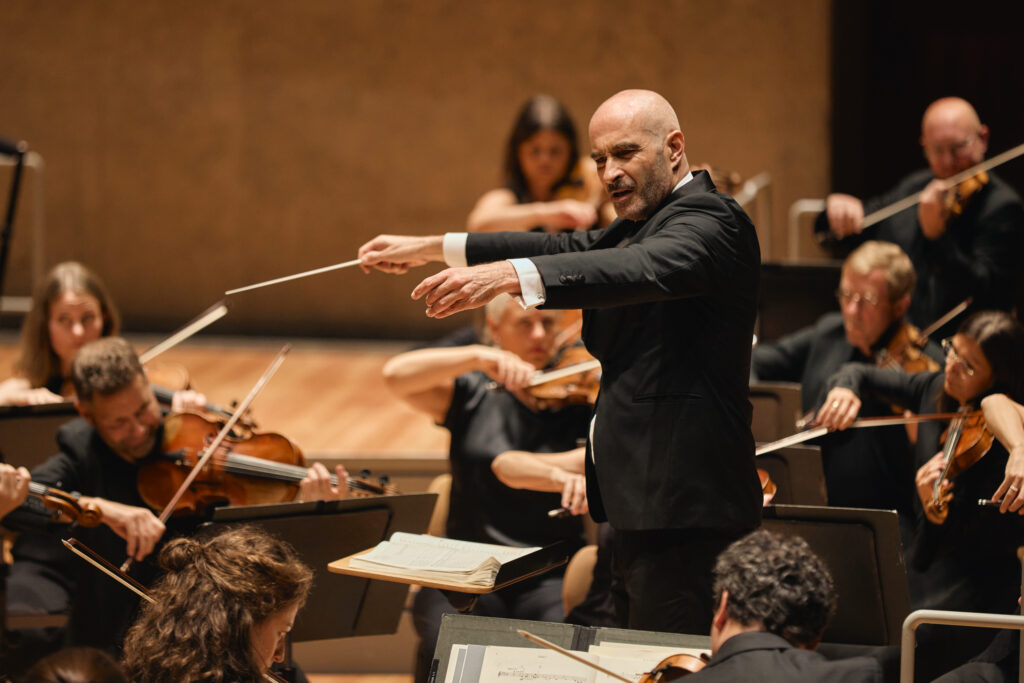
Antonello Manacorda & the Mahler Chamber Orchestra. Photo: Fabian Schellhorn
The ‘Americas’ theme returned in the concert’s second half with a chamber-sized performance of Dvořák’s Symphony No. 9 in E minor, “From the New World”. Italian conductor Antonello Manacorda (a founding member and former concertmaster of the MCO) quickly dispelled any misgivings one might have had regarding scale. He extracted maximum drama and attack from the horns in the opening allegro, and gorgeous intimacy in the famous largo melody, completely original, but inspired by Dvořák’s discovery of African-American spirituals during his three year New York sojourn.
Finnish focus
Staatskapelle Berlin’s Sept. 4th concert had a decidedly Finnish connection. Introductions came from Finland’s Minister of Science and Culture, Sari Multala, who like Winrich Hopp on opening night, injected a political message. She pointed to the role of the arts in promoting cultural diversity and to act as a positive force in a polarised society. Her presence was prompted by one of the festival’s subsidiary focuses, namely, Finnish composer Kaija Saariaho who passed away suddenly in June 2023.
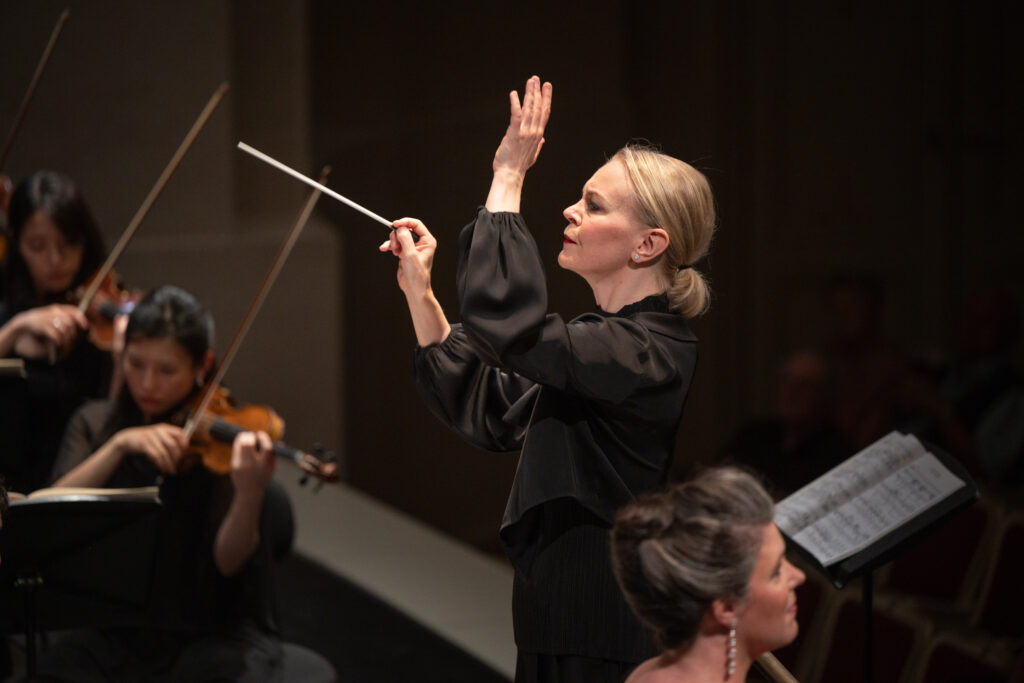
Susanna Mälkki with Staatskapelle Berlin. Photo: Peter Adamik
It wouldn’t be an exaggeration to say that Saariaho was one of the most highly regarded and prolific composers of the past few decades, especially in the realm of opera and vocal music. Her final work however, was the trumpet concerto, Hush, presented here by two Finnish artists involved in its 2023 Helsinki premiere, trumpeter Verneri Pohjola and conductor Susanna Mälkki. Pohjola’s expressive delivery of the concerto’s keening, wailing tones, and his literal screams of pain couldn’t help but remind us that Saariaho composed the piece in the certain knowledge of her own death.
The Finnish composer also featured in Oslo Philharmonic’s Sept. 1st concert led by their Chief Conductor, Klaus Mäkelä. Vista (2019) begins unobtrusively with two oboes in duet but takes the listener on a complete journey including bird-like trumpet sounds and deep, grumbling bass. Saariaho’s aesthetic has always felt like a flash-forward version of Debussyan Impressionism where huge swathes of colour and mood dominate over a sense of line.
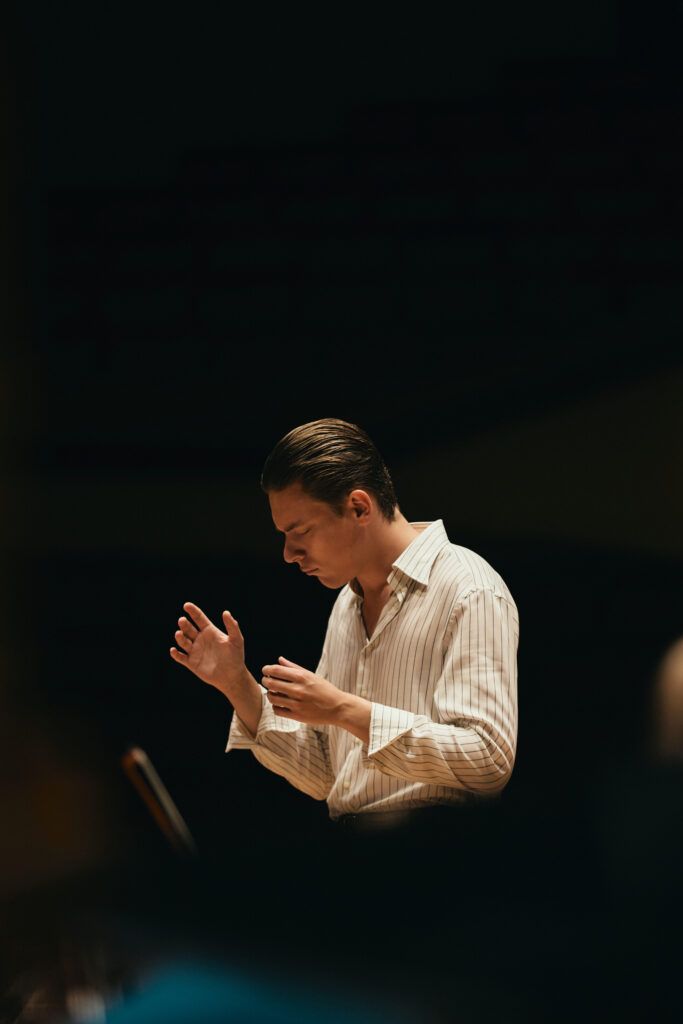
Klaus Mäkelä at Musikfest Berlin. Photo Fabian Schellhorn
Part of conductor Mäkelä’s appeal can be explained by his visceral, dance-like response to music which at times can feel a little self-regarding. This was most clear in Shostakovich’s Symphony no. 5 in D minor, conducted sans score by Mäkelä who inspired a hugely loud and energetic response from his forces in the final movement.
Politics were once again never far from the surface. As the program book pointedly mentions, the border between Finland and Russia measures 1340 km and Norway and Russia also face each other for 197 km on the northern European mainland. “Since Russia’s war of aggression against Ukraine, and since Sweden and Finland joined NATO, these dividing lines have become symbols of a global politics that no one would have thought possible a quarter of a century ago at a time when the St. Petersburg Philharmonic opened Musikfest Berlin in 2000 with a performance of Dmitri Shostakovich’s Leningrad Symphony.” To this listener, it was a reminder of concerns which can seem so far away in North America.
In opposition to Mäkelä’s impetuous youth, two veteran conductors also graced the Philharmonie stage: Riccardo Chailly with the Filarmonica della Scala (Aug. 28th) and Sir Simon Rattle with the Bavarian Radio Symphony Orchestra (Sept. 3rd). In a tribute to Wolfgang Rihm who passed away in July, Chailly lifted the score of his Dis-Kontur (1974, rev. 1984) after a bracing, violent display of percussion that included the huge Mahler mallet in concert with two harps. The La Scala forces also delivered a shimmering account of Ravel’s Daphnis et Chloé symphonic fragments with Chailly demonstrating his mastery of its ebb and flow.
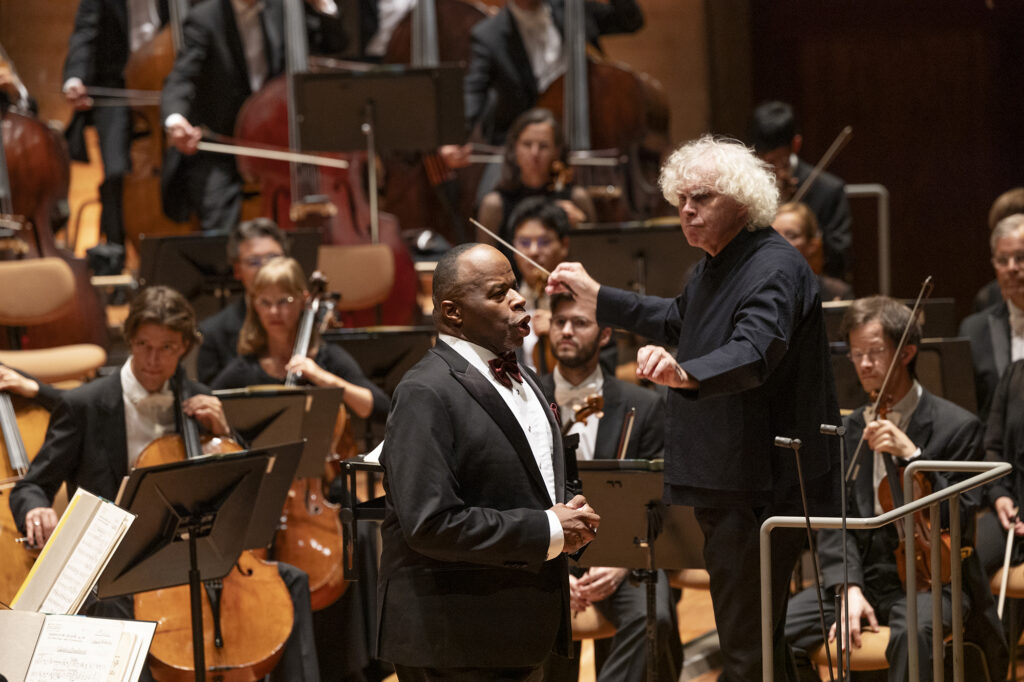
Lester Lynch, Sir Simon Rattle & the Symphonieorchester des Bayerischen Rundfunks. Photo: Astrid Ackermann
After many years at the helm of the Berlin Philharmonic, the Sept. 3rd concert was a chance for the local audience to hear Rattle with his ‘new’ orchestra from Munich. Of particular interest, and taking us back to the Festival’s main theme, were Alexander von Zemlinsky’s Symphonische Gesänge, Op. 20 (Symphonic Songs, 1929) set to texts found in a Viennese anthology of poems from the Harlem Renaissance entitled Afrika Singt (Africa Sings). Here, they were sung by American baritone Lester Lynch who securely managed their high tessitura.
The song set contrasts a pared-down orchestration against incendiary texts that would unlikely get an airing in North America given their inclusion of slurs and racist violence. Several of the poems are by Langston Hughes, one of the great Black American jazz poets and activists. His “Song for a Dark Girl” “illustrates the horror of losing a lover to an arbitrary murder for which there can be no reprisal because of the victim’s skin colour.” (Talk Classical)
These symphonic songs encapsulate Musikfest Berlin’s mission to spark cross-cultural reflection across disparate (or are they?) decades. The thoughtfulness and ingenuity of its programming are inspiring and wholly unique in their scale and ambition.
Musikfest Berlin 2024 continues until Sept. 18th.

